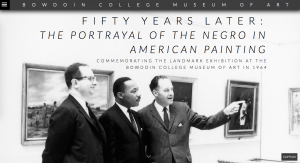Steps toward Recognition through Openness and the Virtual (Fifty Years Later Essay)
My essay, “Steps toward Recognition through Openness and the Virtual,” below was written for the Bowdoin Museum College of Art virtual exhibit “Fifty Years Later: The Portrayal of the Negro in American Painting.” My essay is best preface by reading Dana Byrd and Sarah Montross’s essay, “Fifty Years Later: An Introduction,” which describes the exhibit & site, and I excerpt here.

The Portrayal of the Negro in American Painting was a landmark exhibition organized by and exhibited at the Bowdoin College Museum of Art during the summer of 1964. …[i]t attracted high-profile national attention, including visits and praise from Reverend Dr. Martin Luther King, Jr. … Organized at the height of the civil rights movement, The Portrayal of the Negro in American Painting was recognized at the time for bringing together art and sociology, showing an evolution of the portrayal and roles of African Americans in American society from the colonial period to the present. … Re-examining this exhibition fifty years later allows us to recognize its achievements, but also to question this curatorial approach.
Steps toward Recognition through Openness and the Virtual
by Jen Jack Gieseking
Academics, activists, and business leaders alike call out for cross-disciplinary ventures that address issues of social justice. The digital “open” movement responds by striving “to give access to diverse modes of knowing and becoming rather than a technical label for a publishing or property model.”[1] The complex labor of real collaboration and getting these projects off the ground and out to the public remains less addressed. In this brief essay, I reflect on the work of producing the open and collaborative website, Fifty Years Later: The Portrayal of the Negro in American Painting, and the importance of such digital initiatives when examining issues of social injustice.
The original show, though momentous, has not been recognized in previous scholarship about the history of exhibitions of African-American subjects and artists [2]. The Fifty Years Later website allows the user to experience each of the original artworks in the exhibition in a digital format alongside contemporary reflections about select pieces, the historical period, the context of the museum, and the climate of Bowdoin’s campus amid the civil rights movement. By featuring a digital gallery of reproductions of the works in the show alongside contemporary writing by a new generation of scholars that address broader cultural and historical contexts, this website makes issues of justice and injustice more visible. One of the questions I find myself asking is whether the original exhibition brought about changes in public perception regarding the representation of African Americans in American society? Despite this unresolved issue, this web project surely reveals an obscured past of this exhibition and adds to the necessary work of bringing greater visibility to the under-recognized life, work, and experience of African-Americans.
Our design team—including myself, Cody Stack ’16, Sarah Montross, Andrew W. Mellon Post-doctoral Curatorial Fellow, and Dana E. Byrd, Assistant Professor of Art History—sought to create an useful, exciting, and clean information architecture for this website. Through iterations of information architecture design, web platform choice, and even assignment creation and review, I worked as the translator to bridge these realms. As both a scholar of social and spatial justice and an expert in digital studies, my role inspired many questions for me: What are the limits and affordances of technology for a virtual exhibit? What is the best platform to make this user-friendly not only to the public and scholars? While the site makes the 1964 exhibition more public, how can such openness further our recognition of and actions on issues of race and racism today?
I addressed such questions with a team of experienced scholars and coders over almost a year. We found how exciting and also limiting the possibilities with the new format of a virtual exhibition and addressing such important material therein. For example, our initial interest to include social network analysis with each artwork—records painstakingly found and organized by students Alexandra N’Diaye ’15, Anna Prohl ’14, and Professor Byrd—was found to be unwarranted when the majority of the art had and continued to reside in major cities in the East and Midwest. Nevertheless the written report summarizing this in-depth research reveals other fascinating patterns that now sit aside a provenance map created by Gina Stalica ’16 and myself [3]. This website is the first of its kind for the Bowdoin College Museum of Art. More sites like this will follow and grow across the art world. This will allow for more probing questions to be raised while heightening user experience and extending academic scholarship. As the merit and production of virtual exhibitions grows, it is important to reflect on what exactly we seek to open to the public, the matter in which we do it, and what such openness provides in terms of visibility, recognition, and/or action. The ability to create any steps toward a more just future can never be overlooked.
ENDNOTES
[1] Donovan, Gregory T., and Suzanne Tamang. 2014. “Introduction: Media and Methods for Opening Education.” Journal of Interactive Technology and Pedagogy, no. 5.
[2] See James Denison, Related Exhibitions: 1940—1970s on the Fifty Years Later site
[3] See Dana E. Byrd, Peripatetic Paintings: Provenance and The Negro in American Painting on the Fifty Years Later site